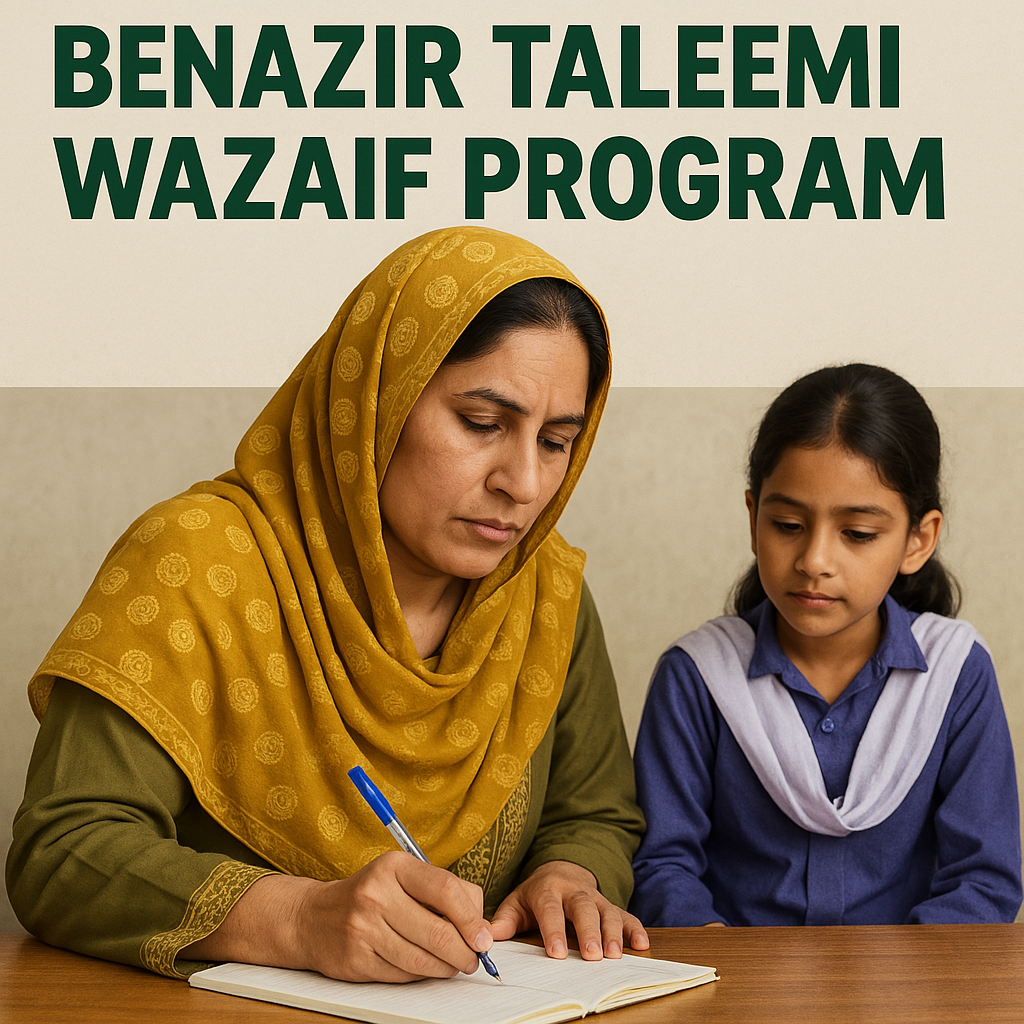Discover the complete guide to the Benazir Taleemi Wazaif Program 2025. Learn about eligibility, registration, benefits, and how this initiative empowers education in Pakistan through conditional cash transfers One of the most impactful and inclusive programs in this regard is the Benazir Taleemi Wazaif Program. Operated under the umbrella of the Benazir Income Support Programme (BISP), this initiative serves as a conditional cash transfer scheme to encourage poor families to send their children to school.
What is the Benazir Taleemi Wazaif Program?
The Benazir Taleemi Wazaif (BTW) program is a conditional cash transfer initiative launched by the Government of Pakistan to improve school enrollment and retention rates among children from low-income families. Introduced in 2012, the program offers financial incentives to families enrolled in the Benazir Kafaalat Program to support their children’s education.
The program targets children between the ages of 4 to 22 years, covering students from primary to higher secondary levels. It ensures that children from marginalized households have access to educational opportunities without facing the burden of associated costs like school supplies, uniforms, and transportation.

Objectives of the Benazir Taleemi Wazaif Program
The primary goals of the Benazir Taleemi Wazaif Program are:
- Increase Enrollment: Encourage families to enroll their children in schools by providing financial incentives.
- Enhance Attendance: Improve school attendance rates by making regular attendance a condition for receiving financial assistance.
- Reduce Dropout Rates: Address financial barriers that cause students to drop out of school.
- Promote Gender Equality in Education: Offer higher incentives for girls to promote female education and bridge the gender gap.
- Support Human Capital Development: Empower the next generation with education to enhance employment opportunities and reduce long-term poverty.
Who is Eligible for Benazir Taleemi Wazaif Program?
The eligibility criteria for the Benazir Taleemi Wazaif Program are as follows:
- Children of active BISP beneficiaries: Only those families already receiving support under the Benazir Kafaalat program are eligible.
- Age Criteria:
- Primary Level: Children aged 4 to 12 years.
- Secondary Level: Children aged 8 to 18 years.
- Higher Secondary Level: Children aged 13 to 22 years.
- School Enrollment: The child must be enrolled in a government-recognized school.
- Minimum Attendance: The student must maintain at least 70% school attendance to continue receiving benefits.
Registration and Enrollment Process
The enrollment process is simple and has been made accessible to accommodate families from rural and underdeveloped regions:
Step 1: Kafaalat Registration
The mother or female guardian must be a registered beneficiary of the Benazir Kafaalat program. If not already registered, she must visit the nearest BISP registration center with her Computerized National Identity Card (CNIC) and undergo the National Socio-Economic Registry (NSER) survey.
Step 2: Taleemi Wazaif Enrollment
Once registered under Kafaalat, the mother can enroll her children into the Taleemi Wazaif program by providing:
- CNIC of the mother
- B-Form of the child issued by NADRA
- Proof of school enrollment (issued by the school head)
- Verified school name and class of the child
Step 3: Biometric Verification
The information is digitally recorded, and biometric verification ensures transparency. After successful verification, the child is enrolled in the program.
Step 4: Attendance Monitoring
To continue receiving stipends, the child must maintain a minimum 70% attendance, verified quarterly through school reports.
Financial Assistance Offered
The cash stipend is disbursed every quarter and varies according to the education level and gender of the student:
| Education Level | Boys (PKR/Quarter) | Girls (PKR/Quarter) |
|---|---|---|
| Primary | 1,500 | 2,000 |
| Secondary | 2,500 | 3,000 |
| Higher Secondary | 3,500 | 4,000 |
In addition to the regular stipends, a one-time graduation bonus of PKR 3,000 is awarded to girls who complete primary education.
Monitoring and Evaluation System
To ensure transparency, accountability, and performance evaluation, the Benazir Taleemi Wazaif Program has implemented a robust Monitoring and Evaluation (M&E) framework:
- Digital Attendance System: Partner schools report attendance electronically.
- Quarterly Verification: Regular checks to confirm that the student continues to meet the attendance requirement.
- Field Verification Teams: Independent teams conduct random visits to schools and homes to verify compliance.
- Grievance Redressal Mechanism: Beneficiaries can report issues through helplines, mobile apps, or BISP offices.
Impact of the Benazir Taleemi Wazaif Program
1. Improved Enrollment Rates
Since its inception, the program has led to a substantial increase in school enrollments, especially in rural and underdeveloped districts of Pakistan. The availability of cash incentives has motivated parents to prioritize education.
2. Reduction in Gender Disparities
By offering higher stipends to girls, the program has helped reduce the gender gap in education. More families are now willing to send their daughters to school.
3. Economic Relief
The stipends serve as a financial cushion for low-income households, easing the burden of educational expenses and preventing child labor.
4. Boost to Education Sector
The increase in student enrollment has encouraged investments in school infrastructure, recruitment of more teachers, and the expansion of digital education initiatives.
Challenges and Limitations
Despite its success, the Benazir Taleemi Wazaif Program faces certain challenges:
- Infrastructure Gaps: Some remote areas still lack functional schools, making it difficult for children to attend regularly.
- Teacher Shortage: The growing number of enrolled students is not matched by sufficient trained teaching staff.
- Digital Divide: Limited internet and technology access hampers digital monitoring in some regions.
- Administrative Delays: Occasionally, delays in stipend disbursement can discourage families from continuing participation.
- Dropout after Primary: While primary level enrollment has improved, dropout rates after primary school remain high due to early marriages, labor demands, or cultural norms.
Government’s Response and Future Plans
To overcome existing hurdles and strengthen the program’s effectiveness, the government is working on several fronts:
1. Expansion of Coverage
Plans are underway to include more deserving families and increase the number of partner schools, especially in underserved regions.
2. Digital Enrollment via Mobile App
A new Benazir Taleemi Wazaif mobile app is being introduced to allow parents to register their children from home and track payment statuses in real time.
3. Increased Budget Allocation
The government is increasing financial allocation to support a higher number of beneficiaries and timely disbursement of funds.
4. Public Awareness Campaigns
Mass awareness drives are being launched to educate communities about the program’s benefits and encourage participation.
5. Partnerships with NGOs and International Donors
Collaboration with organizations like UNICEF, World Bank, and USAID is helping provide technical support, funding, and monitoring expertise.
How to Check Benazir Taleemi Wazaif Program Status Online?
Beneficiaries can check the status of their child’s registration and payment through the following methods:
- BISP Official Website: https://bisp.gov.pk/
- 8171 SMS Service: Send your CNIC to 8171 to check eligibility and payment updates.
- Benazir Wazaif Mobile App: Available for Android users to check application status, attendance updates, and payment history.
- BISP Tehsil Offices: Visit the nearest office for in-person assistance.
Success Stories and Testimonials
Thousands of families across Pakistan have shared stories of how the Benazir Taleemi Wazaif Program has transformed their lives. From rural villages in Punjab to remote districts in Balochistan, families now proudly send both their sons and daughters to school, dreaming of a brighter future. Students who once faced the grim reality of dropping out are now aspiring to become teachers, doctors, engineers, and civil servants.

